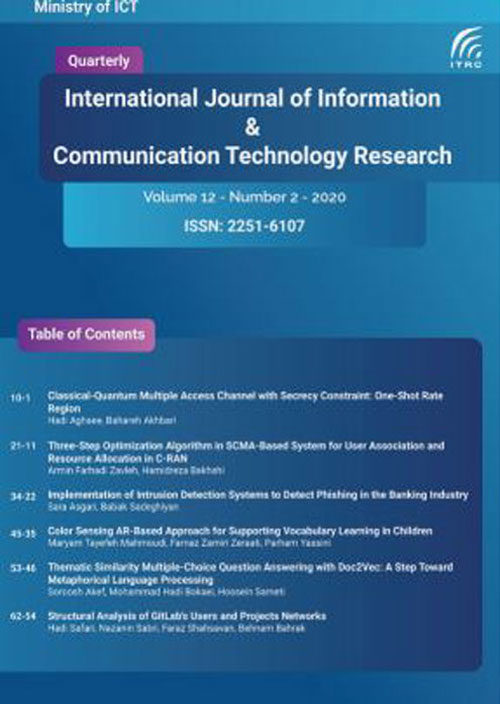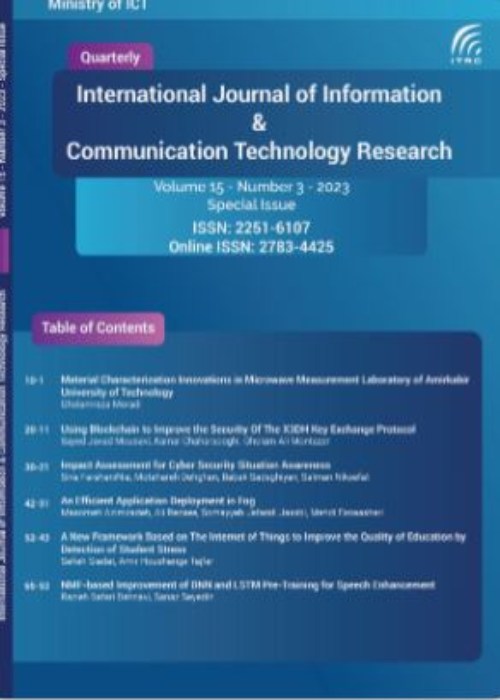فهرست مطالب

International Journal Information and Communication Technology Research
Volume:12 Issue: 3, Summer 2020
- تاریخ انتشار: 1400/07/24
- تعداد عناوین: 6
-
-
Pages 1-8
Presently, due to emergence of new generation of wireless telecommunication networks, some appropriate capacity and coverage have been provided for end-users by new hybrid terrestrial-satellite networks, consisting of two or more satellites in different orbits and terrestrial equipment. Today, due to the lack of spectral resources, a method, such as cognitive radio is used to allow for coexistence of spectrum between different nodes. Therefore, in this paper, spectral coexistence method between two satellites was applied over a common region based on cognition link to manage energy efficiency. Also, for mitigating interferences between satellites in downlink channel, the Stackelberg game was exploited. According to simulation results, the proposed algorithm for a primary satellite system with a main node had more energy efficiency compared to the other algorithms, such as sequential convex approximation (SCA)-based precoding, multi-beam interference mitigation (MBIM), and zero-forcing (ZF)-based precoding.
Keywords: Stackelberg game, Convex optimization, power, interference, Energy efficiency -
Pages 9-15
A compact, tunable and narrowband filter using dual TM mode is presented in Ku-band as a channelizing filter in IMUX of satellite transponders. To shrunken the filter structure while keeping the resonator Q a pair of degenerated modes (TM120, TM210) are exploited. Consequently, a single cavity capable of providing two transmission zeroes besides two poles is achieved. Later, design steps of a four-cavity filter at central frequency of 10.97 GHz with 36 MHz bandwidth are reported and also compared with the experimental results. To improve the passband flatness, chamfered corners with tuning screws are used in the second version of the fabricated filter. The results satisfy the design requirements. The agreement between full wave simulation and the experimental results demonstrates the effectiveness of the proposed design approach.
Keywords: dual-mode, cavity, narrow-band, transverse magnetic (TM) mode -
Pages 16-26
The problem of task scheduling on Virtual Machines is selecting appropriate resources for a task so that its associated tasks have already been executed. Since the workflow contains a set of tasks, the likelihood of failure increases with the failure of a task throughout the workflow. The allocation of tasks on virtual machines with higher reliability improves workflow-scheduling efficiency. Therefore, Trust relationship is an important factor of resource allocation and job scheduling, and in this paper, we have presented a good method to estimate the trust of virtual machines on which the workflow is run. In addition to the trust, which is an important factor in the workflow scheduling, there are other criteria for the satisfaction of service providers and customers. By increasing the number of requests and the diversity of virtual machines as well as the contradiction between objectives, finding the optimal Pareto front is more challenging. Therefore, multi-objective evolutionary algorithms face a large space of permutations to find an optimal tradeoff of objectives. In this paper, we present a multi-objective workflow-scheduling algorithm using Multi-Verse Optimizer algorithm with the aim of increasing diversity and convergence, so that the proposed method can consider Quality of Services requirements for service providers and customers simultaneously. In order to evaluate our proposed method, we have developed WorkflowSim tools. We have extended the original core of these tools to present our algorithm and then compared our proposed method with previous algorithms such as Pareto-Based Grey Wolf Optimizer, Parallel genetic and Strength Pareto Evolutionary Algorithm. The simulation results show that the proposed approach has a good improvement in service quality factors compared to previous methods.
Keywords: work flow, scheduling, Trust, MVO -
Pages 27-37
In the last decades a huge number of information is produced per hour. This collected data can be used in some different fields such as business, healthcare, cybersecurity, after some process etc. in step two, the important process is that when this data is gathered, extraction of useful knowledge should be done from raw information. But the challenge that we face within this process, is the sensitivity of this information, which has made owners reluctant to share their sensitive information. This has led the study of the privacy of data in data mining to be a hot topic today. In this paper, an attempt is made to provide a framework for qualitative analysis of methods. This qualitative framework consists of three main sections: a comprehensive classification of proposed methods, proposed evaluation criteria, and their qualitative evaluation. In this case, we have a most important purpose of presenting this framework:1) systematic introduction of the most important methods of privacy-preserving in data mining 2) creating a suitable platform for qualitative comparison of these methods 3) providing the possibility of selecting methods appropriate to the needs of application areas 4) systematic introduction of points Weakness of existing methods as a prerequisite for improving methods of PPDM.
Keywords: Keywords—Information, Privacy, Data Mining, Privacy preserving Data Mining, PPDM -
Pages 38-46
Nowadays, we face a huge number of high-dimensional data in different applications and technologies. To tackle the challenge, various feature selection methods have been recently proposed for reducing the computational complexity of the learning algorithms as well as simplifying the learning models. Maintaining the geometric structures and considering the discriminative information in data are two important factors that should be borne in mind particularly for unsupervised feature selection methods. In this paper, our aim is to propose a new unsupervised feature selection approach by considering global and local similarities and discriminative information. Furthermore, this unsupervised framework incorporates cluster analysis to consider the underlying structure of the samples. Moreover, the correlation of features and clusters is computed by an -norm regularized regression to eliminate the redundant and irrelevant features. Finally, a unified objective function is presented as well as an efficient iterative optimization algorithm to solve the corresponding problem with some theoretical analysis of the convergence and the complexity of the algorithm. We compare the proposed approach with the state-of-the-art method based on clustering results on the various standard datasets including biology, image, voice, and artificial data. The experimental results have presented the strength and performance improvement of the proposed method by outperforming the well-known methods.
Keywords: Unsupervised feature selection, Similarity preserving, Low dimensional embedding, Cluster analysis, Sparse learning -
Pages 47-59
Despite the increasing development of research in the service supply chain, the IT service supply chain measurements have not grown proportionally. In this paper, based on a survey the key indicators in the IT service supply chain and ranking them, a new hybrid method for measuring the supply chain performance in IT service providers is presented. IT services are examined in three subcategories: Customer Relationship Management (CRM), Supplier Relationship Management (SRM) and Mutual Trust. In this method, comparative vectors in the high dimension space using the AHP method are developed from relationships between effective IT service supply chain factors and the Kernel LS-SVM method is presented for outranking. The Kernel LS-SVM method allows the presentation of mean surface and provides a hyperplane for outranking. The result shows that knowledge and skills, management information system, security service management system, ability to communicate effectively with the customer, ability to establish effective relationships with suppliers, performance of provided services and customer response time, criteria are the highest importance among 112 examined indicators and More attention to them caused an significant increase in quality of measuring the performance of companies.
Keywords: Service Supply Chain, Performance Measurement (SSCPM), Kernels SVM, Ranking AHP Information, Technology Service


